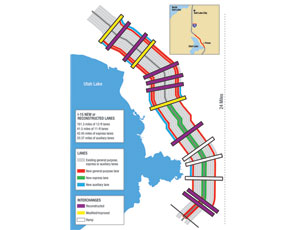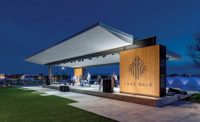Utah’s recent best-value infrastructure procurement for a $1.1-billion highway expansion and reconstruction came with a controversial, unexpected cost: a $13-million payout to the second-place proposer to end its protest of the award.
“In relative terms, it’s a small amount of money,” UDOT Executive Director John Njord says. “A lawsuit would have prevented us from being as creative as possible in the design-build process.
“This was the right business decision,” he adds.
But was it the right political decision in an election year? Utah faces an estimated $28-million budget shortfall for the fiscal year that ended June 30; however, final audited numbers aren’t available until November.
State legislators only recently learned about the deal, as did Gov. Gary Herbert (R), whose re-election campaign received $87,500 from the winning team members. Democratic challenger Peter Corroon questioned whether contributions influenced the contract award—a charge that Herbert, UDOT and Provo River Constructors, the winning proposer, vehemently deny.
“This ill-spirited political attack by Peter Corroon is an affront,” said Guy Wadsworth, president of Wadsworth Brothers Construction, a partner in the winning team, in a Sept. 13 statement. “We have lost many more bids than we have won.”
The seeds of controversy were sown on Dec. 21, 2009, when the Utah Dept. of Transportation awarded the fixed-price design-build Interstate 15 widening contract to Provo River Constructors, a consortium led by Fluor Corp., Irving, Texas. The other members include Ames Construction Inc., Burnsville, Minn., and Wadsworth Bros. Construction Co. Inc. and Ralph L. Wadsworth Construction Co. Inc., both based in Draper, Utah. It bested by one point a team composed of Flatiron Construction Corp., Longmont, Colo.; Parsippany, N.J.-based Skanska USA Building Inc. and Zachry Corp., San Antonio.
The runner-up team claimed in its protest that UDOT’s “arbitrary” judging cost “the public millions of dollars in funds,” and that UDOT “refused” to provide scoring details. Under the settlement terms, the Flatiron-Skanska-Zachry team sold its design to UDOT.
Finalists in the project competition already had been given $1.5-million to defray bid preparation expenses.

ILLIA
There was one key reason for the payout: Delaying construction could have driven up the project cost 3%, or $33 million, annually. The settlement was approved Feb. 11, Njord says.
Njord admits he overlooked an important detail. Utah law requires the governor and legislative leaders to OK settlement payments of more than $1 million, but statute exemptions allow UDOT to resolve construction contract claims without lawmaker approval or notification.
“I should have…made full disclosure to everybody,” Njord told a Sept. 15 state Transportation Interim Committee. “I did not do that and that was my mistake …I am apologetic for that, and I have no excuse.”
In-House Override
UDOT made its request-for-proposal solicitation in 2009 and said it would be based on budget, highest value, schedule, design and public inconvenience.Seventy-five people spent 12,000 hours evaluating and grading proposals. The selection recommendation committee, made-up of senior, experienced UDOT staff, altered the technical committee recommendations.
Based on the committee’s recommendation, Njord and others subsequently awarded the contract to Provo River Constructors, whose proposal shaves nearly two years off UDOT’s planned schedule, finishing in December 2012.
Flatiron-Skanska-Zachary’s proposal, by comparison, added $50-million to $90-million worth of additional bridges, lanes and pedestrian access. The team claimed its added scope could be constructed prior to the end of 2013 and that it fell within the goals set out in UDOT’s evaluation criteria concerning mainline congestion, ramp queuing and aging infrastructure.
“They had an elegant design that could only be partly implemented,” Njord says. “It would have to go through...




Post a comment to this article
Report Abusive Comment